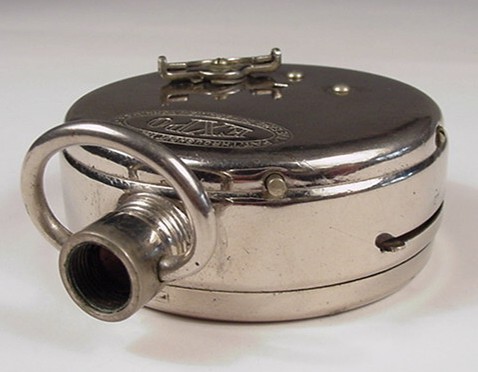
Expo Watch Camera

Designed to be small, easily carried and mistaken as a pocket watch, the Expo Watch camera was a popular novelty, or disguised camera, of the early 1900s. The camera measures 2 1/8 x 7/8 inches and weighs 2 3/4 ounces. The Expo camera was available for over 3 decades. It was introduced in the United States in 1905 and offered for sale as late as 1939.
This view shows the "watch winding stem" which is actually the camera's lens mount. Right of, and above the stem, a round button protrudes from the side of the casing. This is the shutter release. A slot with a protruding metal tab can be seen further right and mid-body in this photo. Pulled half-way along the slot, the tab opens the shutter for time exposures. Pulling the tab fully along the slot arms the shutter for instantaneous shots.
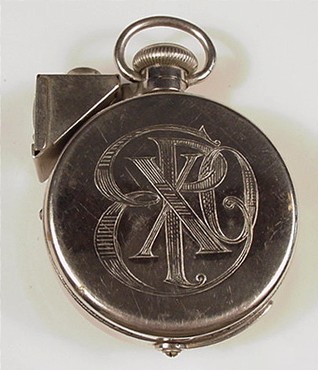
This view shows the EXPO monogram engraved in the camera's cover. The lens cap, shown covering the tip of the winding stem in this image, serves to protect the lens, is used to regulate time exposures, caps the shutter while arming and adds to the pocket watch deception. The Expo shutter is not self-capping, meaning that cocking the shutter exposes the film. Thus, it is necessary to keep the cap on the stem until the shutter is cocked. Once the shutter is set, the cap can be removed and the shutter release pressed to make the exposure.
The triangular object to the left of the stem is the clip-on accessory reflex viewfinder. Expo advertising mentions that a viewfinder is not necessary — you can just point and shoot. The viewfinder was sold separately from the camera. The curved strip of metal at the back of the housing is a lever that is used to pry open the top cover for film loading.
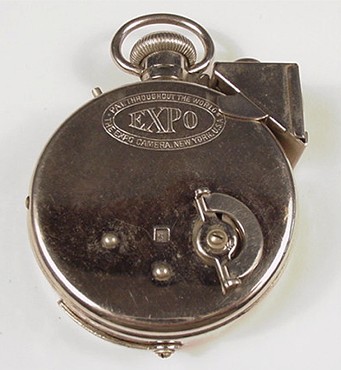
This bottom view, or top depending on your preference, shows the film winding key. The square cut-out to the left of the key is the film counter window. The film counter is numbered to 25.
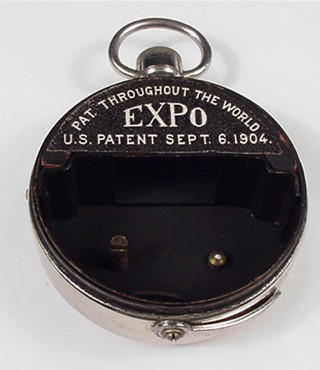
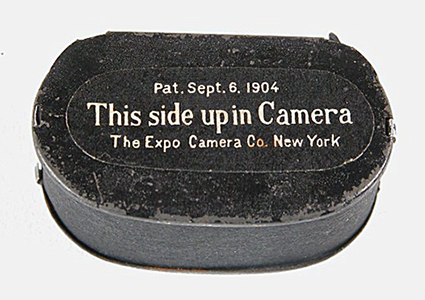
Loading the Expo was a simple process. Simply drop in the daylight loading cartridge and replace the cover. An Expo cartridge provided twenty five 5/8 x 7/8 inch exposures.
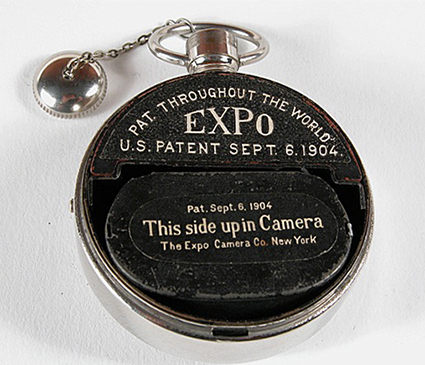
The design of the film cartridge was specified in the Expo patent. Convenient drop-in film loading was a feature ahead of its time. Notice that the lens cap chain is present on this camera from the collection.
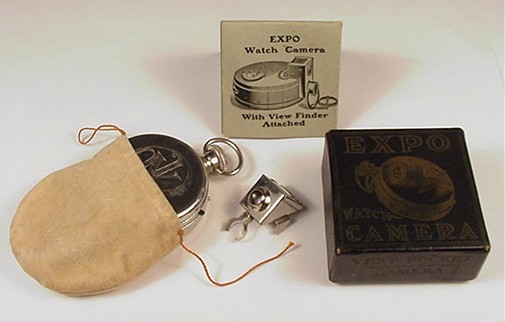
Shown are the Expo instruction manual, box, brilliant reflex viewfinder and Expo in its cloth pouch. At one time a chain attached the lens cap to the winding stem ring but it is now lost. This example may date to ca 1912 as the instruction manual includes an advertisement for the newly introduced Expo Police camera, patented 1911.
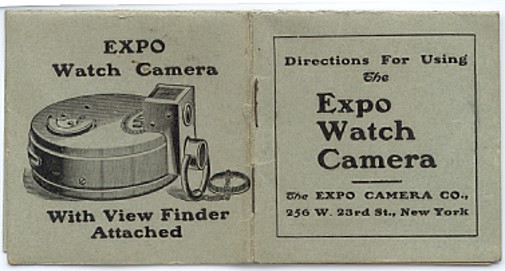
The address of the Expo Camera Company is shown as 256 W. 23rd St., New York.
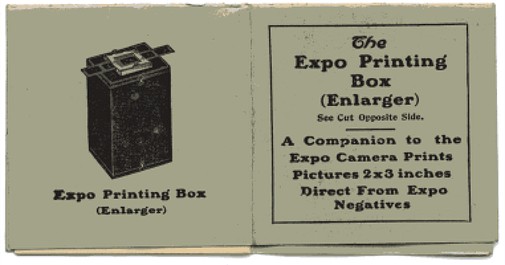
Various accessories were offered for the Expo camera. This is an advertisement for the Expo Enlarger, price $1.50. The manual gives the price of the camera as $2.50. A film cartridge was 25 cents.
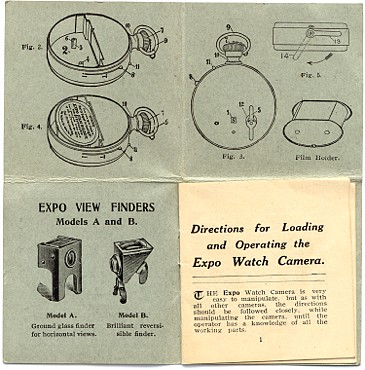
Two versions of the accessory viewfinder were available. The Model A offered ground glass viewing and cost 50 cents. Model B is a brilliant viewfinder, priced at 75 cents.
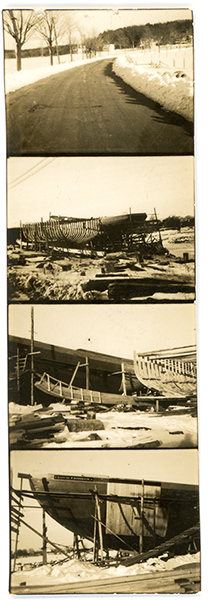
Three photographs in this contact print of Expo Watch camera negatives are of boat building. The name on the hull that is nearing completion is Manuel F. Roderick. The Manuel F. Roderick was a trawler that operated out of Gloucester, Massachusetts. The first photo in the series shows a snow plowed road leading to houses in the distance.
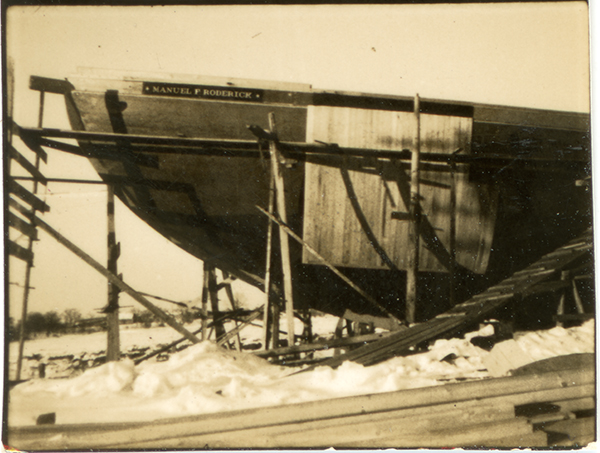
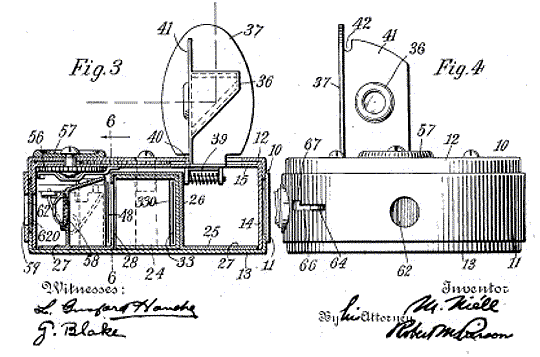
In 1907 Magnus Niéll, the inventor of the Expo Watch camera, filed a patent application for a radically different watch camera design. The patent was granted in 1908. The title of the patent is Vest-Pocket Camera, and in his patent description, Mr. Niéll explains that this design is an improvement over earlier vest-pocket cameras made to resemble a watch.
Among other changes and improvements, the camera features a built-in folding reflex viewfinder. This is a creative and stylish encore to the original Expo design. I've seen photographs of the prototype, and from outward appearance it closely matches the patent drawings, but to my knowledge this version of the Watch camera was not produced for sale.
Magnus Niéll, a citizen of Sweden and resident of New York City, was a creative engineer who focused on the design of small, compact cameras. Two other Niéll designs are featured on this site. These are the Houghton Ensignette and Ensign Midget cameras.

|
Page created April 3, 2002; updated June 16, 2022
|